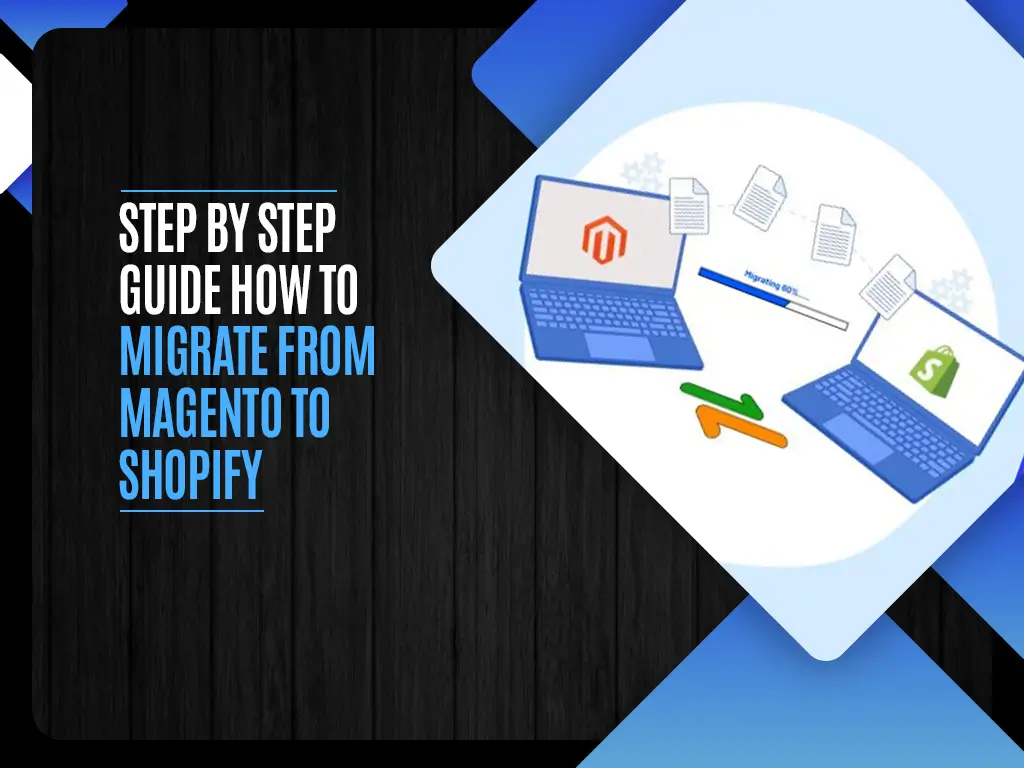Step By Step Guide How to Migrate from Magento to Shopify
Discover a simple, step-by-step guide to migrate your online store from Magento to Shopify. Learn how to transfer products, customers, and orders with ease!

Magento and Shopify are popular eCommerce platforms, offering different features and functionalities to users who want to set up online stores. Many businesses that have tried and tested eCommerce platforms might be aware of the steep learning curve that comes with Magento 2 development.
That’s where Shopify development services come into the picture. These services provide many online businesses with an easy way to set up their stores. Many small and medium-sized stores choose Shopify’s pricing and usability over Magento’s extensive capabilities and diversity.
When brands keep growing and their needs change, Shopify becomes a perfect choice with its flexibility, friendliness, and robust ecosystem. Developmental complexity can be reduced, operation procedures can be simplified, and the user experience enhanced.
If you are thinking of switching from Magento to Shopify, then we’ll walk you through migrating your eCommerce shop from Magento to Shopify while protecting your data.
Four Reasons to Migrate From Magento to Shopify
If you already own an eCommerce business and want to migrate to a reliable eCommerce platform, then Shopify development services are the best option.
The below-listed points will help you understand why you should convert your eCommerce shop to Shopify.
1. Makes setting up the store easy.
Shopify is the easiest platform to use. It doesn’t require any profound technical knowledge. The back end is clean, and the interface is user-friendly and easy to navigate.
2. Offers a variety of themes.
Shopify is loaded with numerous themes, giving you innumerable options for your online Shopify store. You can also customize the themes without any code knowledge.
3. Supports robust marketing tools.
Shopify offers a variety of marketing tools to help you expand your online shop. You may also measure the results with reporting and analytic tools and plan your future moves appropriately.
4. Provides compliant and secure payment processors
Shopify has a payment processor called Shopify Payments and offers more than 100+ paid third-party payment gateways. It is also fully PCI-compliant.
Step-by-Step Migration Guide from Magento to Shopify
To methodically convert the Magento eCommerce shop to Shopify, follow these below-defined step-by-step instructions:
Step 1. Create a Backup of Your Magento Store
Before starting the transfer, make a complete backup of your Magento data, including customer information, product details, and other critical documents. There are usually three types of backups created: system (merges source code and database into a solitary tar archive), database (Magento store data dump), and database and media (preserves your database and media folder content).
Here’s how you can create a backup of your Magento 2 store:
- Click on System on your Magento Admin Dashboard nav, navigate to tools, and click on backups.
- You will have three backup options. Select one of them, and then select a suitable name for your backup file.
- Now, enable Maintenance mode on your website to inform your visitors that it is under maintenance and allow the backup to complete. Verify the action once everything is done by following your Magento website maintenance checklist.
Step 2. Set up a New Shopify Store
Register with Shopify and open your online store. Here’s how you can proceed with the steps:
- Sign up for a Shopify account and choose a pricing plan as per your business requirements.
- Fill in the basic details, including your store name, address, and contact details, and set up your payment gateways.
- Mention your tax rates as per your region, and choose a Shopify theme that resonates with your brand. Customize the theme by adding your brand’s logo, images, and content.
- Now, analyze and configure shipping zones, rates, and options for quick delivery.
- Connect your existing domain to Shopify or buy a new one. Integrate all your social media accounts with your store.
Step 3. Download an Application to Import Data.
There are numerous applications to choose from for moving the data seamlessly. You can use Store Importer, Shopify admin page, Multichannel Importer, etc. For this guide, let’s proceed with LitExtension’s automated migration services. For this, you will have to create an LitExtension account.
Step 4. Set Up the Source Cart & Target Cart.
Now, once you have logged in to your LitExtension account, click on Create Migration. You will have to provide the details for both your Source and Target carts. Select Magento from the dropdown menu and enter your eCommerce store URL.
You will have to download LitExtension Connector, which will act as a bridge between your Magento 2 database and LitExtension. Now, extract the folder from the ZIP file and upload it to Magento’s root folder on your server.
If the installation is successful, you will see a notification like “Connection was successfully installed.” Now, it is time to add Shopify to your Target cart. Enter the Shopify URL and API password. When you are done, click on Next: Configure your Migration.
Step 5. Select Entities to Migrate.
Examine the accessible data entities in your Magento shop, including goods, customers, orders, and more. With LitExtension, you can migrate your data from Magento 2 to the Shopify store. The automated tool provides many options, like products and consumers, or you can even Select All to move everything.
You can set up migration rules to amplify the process. Remember to choose Language Mapping to ensure your migrated data is displayed correctly on your Shopify store. Now, click on Next: Start Full Migration.
Step 6. Start the Full Magento to Shopify Migration.
Now, since you have selected which entities need to be migrated to your new Shopify store, you can sit back and wait for the migration to be completed. All the data transfer will happen seamlessly and securely without you having to keep your system on. Once the migration is successfully done, you will receive a mail notification.
What to Do Next? eCommerce Post-Migration Checklist
After the migration is completed, numerous post-migration operations must be carried out. From setting up 301 redirects to retaining your current SEO rankings, changing your SEO settings, and notifying your consumers of the move, there is so much that needs to be done. If you need help with any step of the transfer process, consider using expert Shopify development services to ensure a smooth transition. Leveraging the expertise of Shopify Experts can further streamline the process by tailoring the migration to your business’s unique needs and ensuring optimal functionality and design.
Follow the post-migration steps to ensure smooth transitioning:
- Check your data after migration, and ensure the data of selected entities were successfully transferred. Key areas to check are products, customers, orders, categories, URLs, and redirects.
- During the migration process, your Magento website will remain up and running. Also, if you are using LitExtension, then their recent data migration services efficiently transfer new entities seamlessly from the source cart to the target cart.
- Install essential Shopify apps to manage and scale up your store efficiently.
- Before launching your Shopify store, conduct thorough testing to catch any potential issues. Focus on responsiveness, the checkout process, links and navigation, and functionality.
Wrapping up,
Migrating your eCommerce shop from Magento to Shopify may transform your business. Shopify’s user-friendly interface, scalability, and robust third-party ecosystem translate into various benefits, including mobile operations, better customer loyalty, and reduced software development complexity.
For store owners seeking expert assistance, working with professionals who specialize in magento to shopify migration ensures a seamless transition, accurate data transfer, and a fully optimized store ready to scale.
The entire process of building a new Shopify store and migration of data can be time-consuming and tedious. If you want top-notch development, then instead of making an eCommerce migration checklist, you can connect with Shopify expert developers. Icecube Digital can help you navigate the process and ensure seamless migration to your new Shopify store.
We are the experts who can make your work easier. Connect with our experts today to find an optimum strategy for simplifying your store operations.



